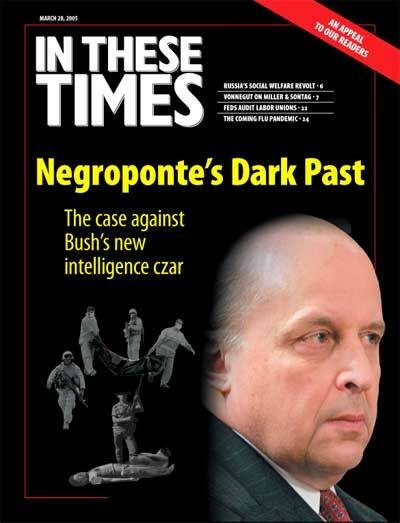Previous Coverage of John Negroponte
In These Times has been following the career of John Negroponte for many years. Here is some of what we have reported.
In These Times Staff
May 4, 1983 — CIA’s Covert Activities Are in the Open
By Jack Epstein and J.H. Evans
The decision to move against Nicaragua was probably taken shortly after Reagan took office. Judging by his campaign rhetoric, the Sandinistas were seen not only as bad examples, but also as willing proxies for Soviet and Cuban support of all leftist insurgent activity in the region. The destruction of the Nicaraguan revolution was perceived as crucial to the maintenance of U.S. hegemony in Central America. …
Honduras, specifically the U.S. embassy in Tegucigalpa, the capital, was chosen as the headquarters for the operation. The embassy was hurriedly upgraded from a low priority class 4 to class 2, and as many as 50 CIA operatives were sent in under official cover to analyze data flowing in from spies. Subsequent press accounts have said that more than 150 agents are now working in Honduras, with dozens more in neighboring countries. This includes between 50 and 60 U.S. military personnel, most of them of Cuban or Puerto Rican descent, who are in charge of daily contact with counter-revolutionary fighters.
To oversee the operation Reagan appointed a former Saigon political officer, John Negroponte, who like his counter part in Guatemala 30 years earlier, John Peurifoy, has become the theater commander of the CIA’s war.
Negroponte immediately began to work closely with Honduran Army Commander-in-Chief General Gustavo Alvarez Martinez, an Argentine and U.S.-trained officer known for his almost messianic anti-Communist views. … Negroponte and the CIA worked through Argentine advisers who helped train the counterrevolutionary groups and launder financial support.
April 2, 2001 — In From the Cold War
Bush’s pick for U.N. Ambassador has some spooky stuff on his resume
By Terry Allen
Like spooks from an abandoned B-Movie graveyard, officials of the Reagan-Bush era are emerging from the dirt and showing up inside the George W. Bush administration. The latest resurrection is John Negroponte, whom Bush recently nominated as ambassador to the United Nations. …
U.S. military aid to Honduras jumped from $ 3.9 million in 1980 to $ 77.4 million by 1984. So crammed was the tiny country with U.S. bases and weapons that it was dubbed the USS Honduras, as if it were simply an off-shore staging ground.
The captain of this ship, Negroponte was in charge of the U.S. Embassy when, according to a 1995 four-part series in the Baltimore Sun, hundreds of Hondurans were kidnapped, tortured and killed by Battalion 316, a secret army intelligence unit trained and supported by the Central Intelligence Agency. … Members of Battalion 316 were trained in surveillance and interrogation at a secret location in the United States and by the CIA at bases in Honduras. …
Negroponte tried to distance himself from the pattern of abuses, even after a flood of declassified documents exposed the extent of U.S. involvement with Battalion 316. In a segment of the 1998 CNN mini-series Cold War, Negroponte said that “some of the retrospective effort to try and suggest that we were supportive of, or condoned the actions of, human rights violators is really revisionistic.” …
Negroponte … annually filed State Department reports from Honduras that gave the impression that the Honduran military respected human rights. But in an interview with In These Times, Negroponte’s predecessor as ambassador, Carter appointee Jack Binns, tells a different story: “Negroponte would have had to be deliberately blind not to know about human rights violations.” … In the summer of 1981, Binns recalls, “I was called unexpectedly to Washington by Tom Enders, the assistant secretary of state. He asked me to stop reporting human rights violations through official State Department channels and to use back channels because they were afraid of leaks.” … Binns did not agree to use back channels and when he returned to Honduras, he received no further reports of human rights violations from the CIA. “I was deliberately lied to,” says Binns. …
The lessons Negroponte has learned from the past may shed light on what kind of U.N. ambassador he will be if his nomination is approved by the Senate. When he appeared in 1981 before a Senate committee for confirmation as envoy to Honduras, he said, “I believe we must do our best not to allow the tragic outcome of Indochina to be repeated in Central America.”
The tragedy to which he referred, of course, was the defeat of the United States, not the devastation and death caused by U.S. intervention.
June 21, 2004 — Déjà Violence
By Joel Bleifuss
For all the hooha over the horror of U.S. treatment of Iraqi prisoners, the fact is such torture has been the rule, not the exception. Indeed, this scandal features a cast of characters who were in power the last time the U.S. sanctioned torture. … Who could forget John Negroponte? Between 1981 and 1985, he was the U.S. ambassador to Honduras … overseeing the construction of El Aguacate airbase, which was used as a U.S. training camp for the Nicaraguan Contras and as a torture center for Battalion 316, a Honduran army intelligence unit. The Baltimore Sun reported in 1995 that Battalion 316, which was trained and supported by the CIA, used “shock and suffocation devices in interrogations. Prisoners often were kept naked and, when no longer useful, killed and buried in unmarked graves.” In August 2001, a mass grave was unearthed at El Aguacate containing 185 corpses, including two Americans.
Negroponte will become the U.S. ambassador to Iraq in July. Judging by his record, he is the man for the job.
The use of torture by the Honduran army under U.S. guidance was not an aberration but a matter of policy. … The U.S. Army used CIA-prepared torture manuals to train foreign military officers both at the School of the Americas and on-site in Latin America. One of these, the Human Resource Exploitation Training Manual — 1983, had these tips:
The threat of coercion usually weakens or destroys resistance more effectively than coercion itself. For example, the threat to inflict pain can trigger fears more damaging than the immediate sensation of pain. … A threat should be delivered coldly, not shouted in anger. … If a subject refuses to comply once a threat has been made, it must be carried out. The torture situation is an external conflict, a conflict between the subject and his tormentor.
The CIA’s training manual does caution, “The routine use of torture lowers the moral caliber of the organization that uses it and corrupts those that rely on it.” Look no further than the Bush administration.





